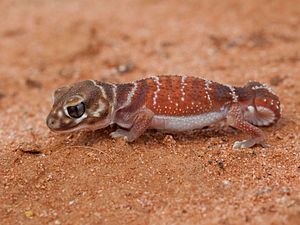Smooth button-tailed gecko
This article was based on formal or substantive deficiencies in the quality assurance biology in the section "Reptiles" entered for improvement. This is done in order to bring the quality of the biology articles to an acceptable level. Please help improve this article! Articles that are not significantly improved can be deleted if necessary.
Read the more detailed information in the minimum requirements for biology articles .
Reason: Wrong lemma, unsuitable literature
| Smooth button-tailed gecko | ||||||||||||
|---|---|---|---|---|---|---|---|---|---|---|---|---|

Smooth button-tailed gecko |
||||||||||||
| Systematics | ||||||||||||
|
||||||||||||
| Scientific name | ||||||||||||
| Nephrurus levis | ||||||||||||
| De Vis , 1886 |
The smooth button- tailed gecko ( Nephrurus levis ) is an approx. 15 centimeter long member of the gecko-like group . There are three known subspecies.
Appearance
The animals have a short, flat body and a very large head. You have very big eyes. The very short tail has a rounded thickening at the end, the actual purpose of which is unknown. The brown to red-brown coloration of the smooth button-tailed gecko can only be found on the upper side of the body, the head, the legs and the tail. The belly is white.
habitat
This species inhabits the desert areas in the interior of the Australian continent up to the west coast.
Way of life
This species is primarily active at night and at dawn, and spends the day sleeping under rocks. It mainly hunts invertebrates . When in danger he runs towards his enemies and lets out a very high-pitched squeak to scare them off. If the attacker is confused afterwards, the button-tailed gecko takes advantage of this moment to get to safety under stones or in a hole in the ground.
Reproduction
The female usually only lays 2 eggs, which are hidden under rocks or in crevices. There is no brood care.
Hazards and protective measures
Since no endangerments are known for this species and it also occurs in protected areas, it is listed by the IUCN as ( Least Concern ) not endangered.
literature
- Jiří Felix (eds.), Alena Čepická, Jaromír Knotek, Libuše Knotková: Wildlife of Australia and the Antarctic. Translated from the Czech by Ingeborg Šestáková. Arita, Prague 1986, p. 122.
Web links
- Nephrurus levis in The Reptile Database
- Nephrurus levis inthe IUCN Red List of Threatened Species 2018.1. Posted by: Shea, G., Ellis, R., Wilson, S. & Oliver, P., 2017. Retrieved September 24, 2018.
